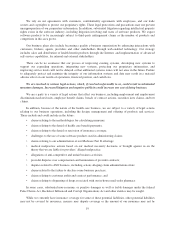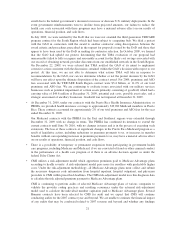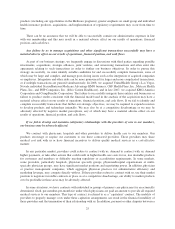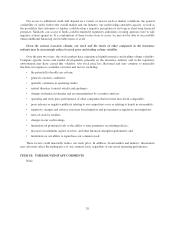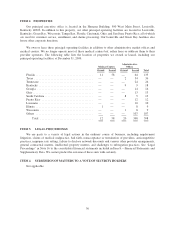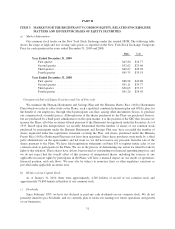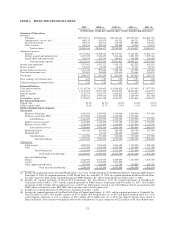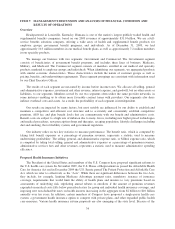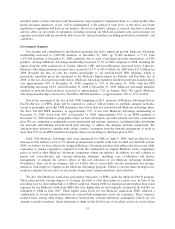Humana 2009 Annual Report Download - page 37
Download and view the complete annual report
Please find page 37 of the 2009 Humana annual report below. You can navigate through the pages in the report by either clicking on the pages listed below, or by using the keyword search tool below to find specific information within the annual report.If we do not continue to earn and retain purchase discounts and volume rebates from pharmaceutical
manufacturers at current levels, our gross margins may decline.
We have contractual relationships with pharmaceutical manufacturers or wholesalers that provide us with
purchase discounts and volume rebates on certain prescription drugs dispensed through our mail-order and
specialty pharmacies. These discounts and volume rebates are generally passed on to clients in the form of
steeper price discounts. Changes in existing federal or state laws or regulations or in their interpretation by courts
and agencies or the adoption of new laws or regulations relating to patent term extensions, and purchase discount
and volume rebate arrangements with pharmaceutical manufacturers, may reduce the discounts or volume rebates
we receive and materially adversely impact our results of operations, financial position, and cash flows.
Our ability to obtain funds from our subsidiaries is restricted.
Because we operate as a holding company, we are dependent upon dividends and administrative expense
reimbursements from our subsidiaries to fund the obligations of Humana Inc., our parent company. These
subsidiaries generally are regulated by states’ Departments of Insurance. We are also required by law to maintain
specific prescribed minimum amounts of capital in these subsidiaries. The levels of capitalization required
depend primarily upon the volume of premium generated. A significant increase in premium volume will require
additional capitalization from our parent company. In most states, we are required to seek prior approval by these
state regulatory authorities before we transfer money or pay dividends from these subsidiaries that exceed
specified amounts, or, in some states, any amount. In addition, we normally notify the state Departments of
Insurance prior to making payments that do not require approval. In the event that we are unable to provide
sufficient capital to fund the obligations of Humana Inc., our results of operations, financial position, and cash
flows may be materially adversely affected.
Downgrades in our debt ratings, should they occur, may adversely affect our business, results of
operations, and financial condition.
Claims paying ability, financial strength, and debt ratings by recognized rating organizations are an
increasingly important factor in establishing the competitive position of insurance companies. Ratings
information is broadly disseminated and generally used throughout the industry. We believe our claims paying
ability and financial strength ratings are an important factor in marketing our products to certain of our
customers. Our 7.20% and 8.15% senior notes are subject to an interest rate adjustment if the debt ratings
assigned to the notes are downgraded (or subsequently upgraded) and contain a change of control provision that
may require us to purchase the notes under certain circumstances. In addition, our debt ratings impact both the
cost and availability of future borrowings. Each of the rating agencies reviews its ratings periodically and there
can be no assurance that current ratings will be maintained in the future. Our ratings reflect each rating agency’s
opinion of our financial strength, operating performance, and ability to meet our debt obligations or obligations
to policyholders, but are not evaluations directed toward the protection of investors in our common stock and
should not be relied upon as such.
Historically, rating agencies take action to lower ratings due to, among other things, perceived concerns
about liquidity or solvency, the competitive environment in the insurance industry, the inherent uncertainty in
determining reserves for future claims, the outcome of pending litigation and regulatory investigations, and
possible changes in the methodology or criteria applied by the rating agencies. In addition, rating agencies have
come under recent regulatory and public scrutiny over the ratings assigned to various fixed-income products. As
a result, rating agencies may (i) become more conservative in their methodology and criteria, (ii) increase the
frequency or scope of their credit reviews, (iii) request additional information from the companies that they rate,
or (iv) adjust upward the capital and other requirements employed in the rating agency models for maintenance
of certain ratings levels.
27




